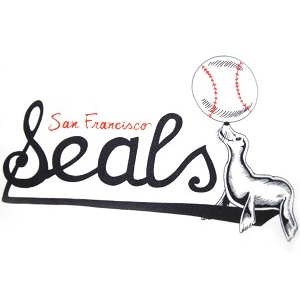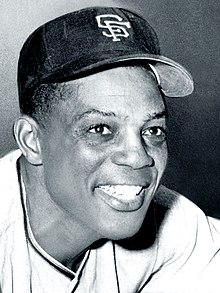
The San Francisco Giants are an American professional baseball team based in San Francisco. The Giants compete in Major League Baseball (MLB) as a member club of the National League (NL) West division. Founded in 1883 as the New York Gothams, the team was renamed the New York Giants three years later, eventually relocating from New York City to San Francisco in 1958.

Candlestick Park was an outdoor stadium on the West Coast of the United States, located in San Francisco's Hunters Point area. The stadium was originally the home of Major League Baseball's San Francisco Giants, who played there from 1960 until 1999, after which the Giants moved into Pacific Bell Park in 2000. It was also the home field of the San Francisco 49ers of the National Football League from 1971 through 2013. The 49ers moved to Levi's Stadium in Santa Clara for the 2014 season. The last event held at Candlestick was a concert by Paul McCartney in August 2014, and the demolition of the stadium was completed in September 2015. As of 2019, the site is planned to be redeveloped into office space.

Oracle Park is a baseball stadium in the SoMa district of San Francisco, California. Since 2000, it has served as the ballpark of Major League Baseball's San Francisco Giants. Previously named Pacific Bell Park, SBC Park, and AT&T Park, the stadium's current name was purchased by the Oracle Corporation in 2019.

Wrigley Field was a ballpark in Los Angeles, California. It hosted minor league baseball teams in the region for more than 30 years. It was the home park for the minor league Los Angeles Angels during their run in the Pacific Coast League, as well as for the inaugural season of the major league team of the same name in 1961. The park was designed by Zachary Taylor Davis, who had previously designed both of the Major League Baseball stadiums in Chicago: Comiskey Park and Wrigley Field. The ballpark was also used as the backdrop for several Hollywood films about baseball, as well as the 1960 TV series Home Run Derby.

The San Francisco Seals were a minor league baseball team in San Francisco, California, that played in the Pacific Coast League from 1903 until 1957 before transferring to Phoenix, Arizona. The organization was named for the abundant California sea lion and harbor seal populations in the Bay Area. The 1909, 1922, 1925, and 1928 Seals were recognized as being among the 100 greatest minor league teams of all time.

Francis Joseph "Lefty" O'Doul was an American Major League Baseball player who went on to become an extraordinarily successful manager in the minor leagues. He was also a vital figure in both the pre-war establishment and post-war revival of professional baseball in Japan.

Horace Charles Stoneham was an American Major League Baseball executive and the owner of the New York / San Francisco Giants from 1936 to 1976.
The Los Angeles Dodgers took the field before 78,672 fans at the Los Angeles Memorial Coliseum on April 18, 1958, to usher in the beginning of the team's new home in Los Angeles. It was a rough season, as the Dodgers finished 21 games in back of the pennant-winning Milwaukee Braves in the National League standings, but it was the beginning of the second phase for the team. Vin Scully and company moved to KTTV (television) and KMPC (radio) from that year onward, and the Dodgers became one of the first teams that commenced Spanish language radio broadcasts for Latinos, with KWKW as the first station to offer a Spanish-language service.
The 1962 San Francisco Giants season was the Giants' 80th year in Major League Baseball, their fifth year in San Francisco since their move from New York following the 1957 season, and their third at Candlestick Park. The team finished in first place in the National League with a record of 103 wins and 62 losses. They finished the season tied with their arch-rivals, the Los Angeles Dodgers, for first place in the league, necessitating a three-game tiebreaker playoff to determine the pennant winner. The Giants won two of the three games to take their first National League title since moving to San Francisco, making the Giants the first NL Champions of the 162-game schedule era. They went on to the 1962 World Series, where they lost in seven games to the New York Yankees. The Giants had 1,552 hits in the regular season, the most in the club's San Francisco era.
The 1958 San Francisco Giants season was the franchise's first season in San Francisco, California and 76th season overall. The Giants' home ballpark was Seals Stadium. The team had a record of 80–74 finishing in third place in the National League standings, twelve games behind the NL Champion Milwaukee Braves.
The 2000 San Francisco Giants season was the Giants' 118th season in Major League Baseball and their 43rd season in San Francisco since their move from New York following the 1957 season. The Giants finished in first place in the National League West with a record of 97 wins and 65 losses, which was the best record in the major leagues in 2000. They lost the National League Division Series in four games to the New York Mets. The team played their first season in newly opened Pacific Bell Park. The Giants had 889 runs batted in (RBI), the most in franchise history, while their 925 runs scored is the most in the club's San Francisco era.
The 1959 San Francisco Giants season was the Giants' 77th year in Major League Baseball and their second season in San Francisco since their move from New York following the 1957 season. The team finished in third place in the National League with an 83–71 record, 4 games behind the World Champion Los Angeles Dodgers. It was the team's second and final season at Seals Stadium before moving their games to Candlestick Park the following season.
The 1960 San Francisco Giants season was the Giants' 78th year in Major League Baseball. The team moved their home games from Seals Stadium to the new Candlestick Park. In their third season in the Golden Gate City, the Giants finished in fifth place in the National League, 16 games behind the World Champion Pittsburgh Pirates. The Giants hit 62 triples, the most in the club's San Francisco era.
The 1963 San Francisco Giants season was the Giants' 81st year in Major League Baseball, their sixth year in San Francisco since their move from New York following the 1957 season, and their fourth at Candlestick Park. The team finished in third place in the National League with an 88–74 record, 11 games behind the Los Angeles Dodgers.
The 1965 Major League Baseball season was contested from April 12 to October 14, 1965. The Los Angeles Dodgers and Minnesota Twins were the regular season champions of the National League and American League, respectively. The Dodgers then defeated the Twins in the World Series, four games to three.
The 1958 Major League Baseball season was played from April 14 to October 15, 1958. It was the first season of play in California for both the Los Angeles Dodgers and the San Francisco Giants ; this marked the first teams to be played on the West Coast. Three teams had relocated earlier in the decade: the Milwaukee Braves, Baltimore Orioles, and Kansas City Athletics. New York went without a National League team for four seasons, until the expansion New York Mets began play in 1962.
The 1962 National League tie-breaker series was a best-of-three playoff series that extended Major League Baseball's (MLB) 1962 regular season to determine the winner of the National League (NL) pennant. The games were played from October 1 to 3, 1962, between the Los Angeles Dodgers and the San Francisco Giants. The Giants won the series, two games to one. The first game took place at Candlestick Park and the second and third were played at Dodger Stadium. The tie-breaker series was necessary after both teams finished the season with identical win–loss records of 101–61. The Dodgers won a coin flip late in the season, which gave them home field advantage. The series was broadcast nationally by NBC television, with Bob Wolff, George Kell, and Joe Garagiola announcing, and NBC Radio, with Al Helfer and George Kell announcing.











